10 Best Cable Back Workout Exercises
The 10 Best Cable Exercises for a Strong, Muscular Back
Developing a strong, muscular back is critical for overall fitness, proper posture, injury prevention, and an impressive physique.
Cable machines offer unique benefits for back training that free weights alone cannot provide.
Cables provide constant tension throughout the movement, allow for full range of motion, and enable you to hit the back muscles from varied angles for comprehensive development.
In this definitive guide, we will cover why cables are so effective for the back, muscles involved, the top cable variations to incorporate, and sample back workout routines.
Read on to learn how to build a bigger, stronger back with cables.
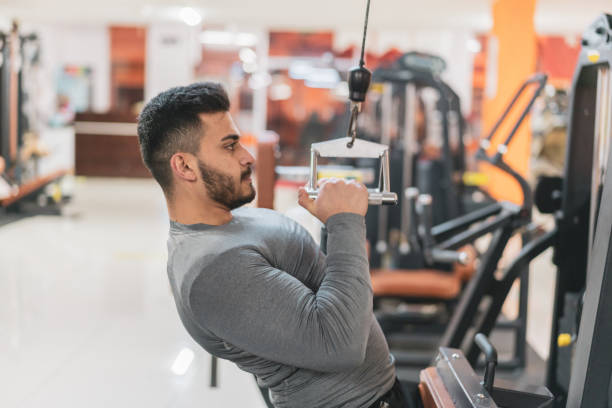
What Makes Cables Ideal for Back Training?
Cable machines are versatile tools found in most gyms. They utilize adjustable pulleys and resistance cables rather than traditional dumbbells or barbells. This system provides key advantages:
Full Range Motion with Constant Tension
Unlike free weights which lose tension at the top and bottom of a movement, cables keep constant tension on the working muscle throughout the full range of motion. This leads to better muscle activation and development through the entirety of the rep.
Suit All Fitness Levels
The resistance of cable machines is easily adjustable to suit beginners using light weight as well as advanced lifters progression to heavier resistance as they get stronger. This makes cables suitable for lifters at all stages.
Muscle Isolation
Cables allow you to isolate specific sections of the back from different angles. For example, the lats can be targeted with front pulldowns while the middle back is focused on during rows. This precision targeting is difficult to achieve with compound back exercises like deadlifts or chin-ups.
Prevents Cheating
The continual tension of cables through the full movement keeps constant load on the target muscles so you cannot use momentum or gravity to cheat, forcing proper form and muscle activation.
Versatility
There are many single and dual cable station options allowing you to perform a wide variety of back-focused moves. Cable attachments like straight bars, rope handles, V-bars, and handles provide further options to continually challenge the back musculature in new ways.
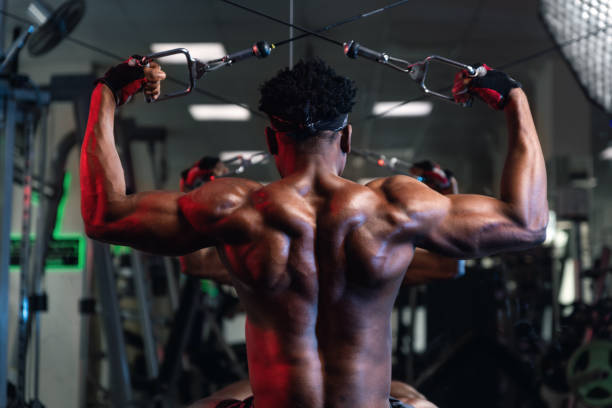
Anatomy of the Back
Before diving into the best cable back exercises, let’s briefly overview the major muscle groups cables target:
Latissimus Dorsi
The lats are the large, V-shaped muscles running vertically down the back. Cables directly target the lats with pulldown motions.
Trapezius
The trapezius muscles of the upper back run from the base of the neck out to the shoulders. Cable rows engage the traps efficiently.
Rhomboids
The rhomboids connect the shoulder blades to the spinal column. They assist with scapular retraction during rows.
Teres Major and Minor
The teres muscles origin along the upper arm bone and insert into the scapula. They rotate the shoulders internally during rows or pulldowns.
Erector Spinae
The erector spinae muscles run vertically to hold up and stabilize the spine. They assist with spinal extension during back moves.
Now that you know the major muscles, let’s get into the top cable variations!

Best Cable Back Exercises
Here are the top cable back exercises to incorporate for full back development along with clear instructions on proper form:
1. Cable Lat Pulldown
- Grip straight bar attached to top pulley using overhand grip at shoulder width.
- Sit tall keeping chest lifted and arch lower back slightly.
- Initiate movement by pulling shoulders blades down and back then drive elbows down past sides.
- Bring bar to upper chest below the collar bone.
- Slowly return to start position keeping tension on lats.
- Key points is to keep core braced and avoid excessive leaning or swinging.
Variations: Underhand grip, wide overhand grip, V-bar, rope attachment. Can also be done standing.
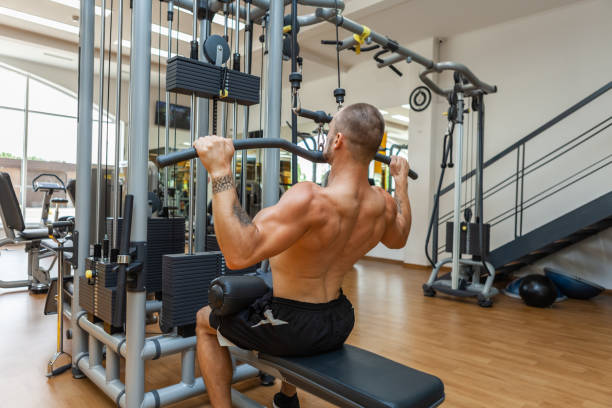
2. Cable Seated Row
- Attach rope or handles to low pulley at mid torso height.
- Hinge forward at the hips with engaged core, flat back.
- Initiate movement by driving elbows back, pinching shoulder blades together.
- Control return until arms are straight, not letting shoulders round forward.
- Key point is to keep chest lifted throughout motion.
Variations: Single arm, reverse grip, low row.
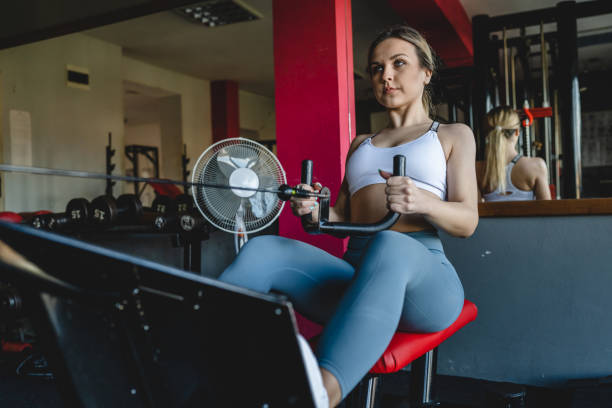
3. Cable Straight Arm Pushdown
- Grip ends of rope attached to top pulley using neutral grip.
- Stand upright a few feet back with engaged core.
- Initiate movement by pulling shoulders down then push rope directly down until arms are straight.
- Slowly return to start letting biceps stretch.
- Key point is keeping arms directly perpendicular to floor and stable torso.
Variations: Rope attachment, bar attachment, forward lean.
4. Cable Lying Chest Pullover
- Attach a curl bar or ropes to low pulley and lie perpendicular with hips under pulley.
- Grasp bar above chest with arms straight and palms down.
- Keeping fixed bend in elbows, arc bar back behind head in sweeping motion.
- Return bar controlled to start getting full chest and lat stretch.
- Key points are keeping feet firmly planted and core engaged throughout motion.
Variations: Lying on stability ball, arms extended overhead.
5. Cable Shrug
- Attach dual handles to middle pulleys at shoulder height.
- Stand upright gripping handles with palms facing thighs.
- Initiate movement by elevating shoulders straight up towards ears.
- Slowly lower shoulders downward to complete rep.
- Key points are avoiding swinging with momentum or twisting shoulders. Proper form is key.
Variations: Single arm, front of body cable shrugs.
6. Cable Upright Row
- Attach straight bar to top pulley at shoulder height.
- Stand holding bar with narrow underhand grip.
- Initiate movement by driving elbows up and back, raising bar to upper chest.
- Slowly lower bar back down controlling weight.
- Key points are keeping wrists straight and avoiding leaning back.
Variations: Rope handle, overhand grip.
7. Cable Back Extension
- Attach rope or bar to low pulley and sit facing machine.
- Bend forward at hips until torso is parallel with floor with legs straight and engaged core.
- Initiate movement by pulling rope upwards and driving elbows back behind body.
- Return under control letting abdominals stretch.
- Key points are proper spinal alignment and avoiding hyper-extending low back.
8. Cable Neutral Grip Lat Pulldown
- Attach a straight bar to the top pulley of a cable station
- Grip the bar with hands shoulder-width apart and palms facing each other in neutral position
- Sit tall on the seat with engaged core and slight arch in lower back
- Initiate movement by pulling shoulders down and back
- Bring the bar to upper chest under the collarbone
- Slowly return to the start position with control
Benefits
- Puts less stress on the wrists compared to regular grip
- Allows for greater range of motion stretch in the lats
- Emphasizes the lower lats due to grip width and internal rotation
- Provides variation to muscle stimulus compared to normal pulldown grip
9. Cable X-Row
- Attach handles to bottom pulleys in X formation.
- Assume athletic stance with engaged core.
- Initiate movement by driving elbows back and pinching shoulder blades together.
- Return under tension with controlled motion.
- Key points are keeping chest lifted and stable torso position. Great for upper back!
Variations: Single arm X-row.
10. Cable Bent Over Row
- Attach a straight bar to the lower cable pulley
- Hinge at the hips with flat back, engaged core, slight knee bend
- Grip bar using underhand grip at shoulder width
- Initiate movement by driving elbows back, pinching shoulder blades
- Raise bar to lower chest height with control
- Slowly return to start position with tension
- Key points are flat back, chest lifted, and squeezed shoulder blades
Benefits
- Targets middle-upper back musculature including lats, traps, rhomboids
- Hits back muscles from a different angle than seated rows
- Allows for greater range of motion stretch and contraction
- Easy to adjust cable resistance as you get stronger
The cable bent over row is an effective variation to hit the back in a compound movement pattern nearly identical to the classic barbell row but with more stabilization required. Include in workouts after vertical pulls for balanced development.
Sample Back Workout Routines
Now that we have covered the top cable back exercises, here are 3 sample routines from beginner to advanced:
Beginner Cable Back Routine 3 sets x 10-12 reps each exercise
- Seated Cable Row
- Cable Lat Pulldown
- Single Arm Cable Row
Intermediate Cable Back Routine 3 sets x 8-10 reps each exercise
- Wide Grip Lat Pulldown
- Single Arm Cable Row
- Cable Back Extension
- Cable X-Row
Advanced Cable Back Blast 4 sets x 6-8 reps each exercise
- Underhand Cable Lat Pulldown
- Wide Grip Cable Row
- Lying Cable Pullover
- Cable Shrugs
- Cable Rope Straight Arm Pullover
Make sure to include a proper dynamic warm up prior to lifting.
Focus on progressive overload by using challenging weight each set and improving rep quality over time.
Adjust routines to prevent excessive fatigue and allow for adequate muscle recovery between sessions.
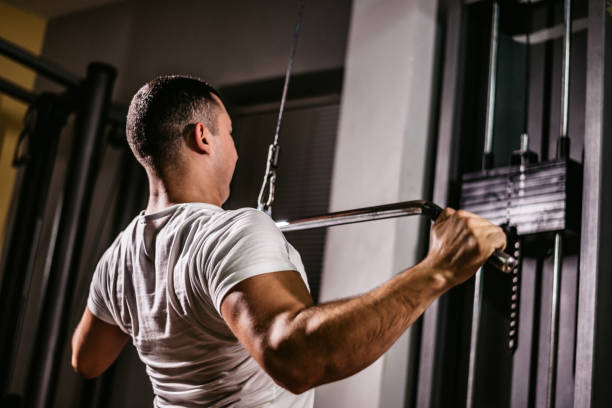
Maximizing Results from Cable Training
Here are some top tips for getting the most effective back workouts from cables:
- Control the eccentric and concentrate on the contraction
- Maintain proper spinal alignment with flat lower back
- Get full range of motion squeeze and stretch
- Avoid excessive use of momentum or body English on lifts
- Use controlled, defined form keeping constant tension
- Focus on mind-muscle connection visualizing the back muscles working
Training with cables 1-2 times per week in conjunction with deadlifts, rows, and pull-ups can build an impressively muscular, functionally strong backside. Be patient and consistent in your approach for best results.
I hope you found this cable back workout guide useful! Let me know if you have any other questions in the comments. Now get to the gym and train hard!
Frequently Asked Questions (FAQs)
What are the benefits of a cable back workout?
Cable back workouts are effective for building strength and muscle mass. They allow you to target specific muscles in the back, such as the latissimus dorsi, with exercises like the cable pulldown and cable row.
The constant tension provided by the cable pulley system ensures a consistent workout for all targeted muscle groups.
How does a cable row benefit back muscles?
The cable row is a compound exercise that targets multiple back muscles, including the upper and middle back muscles. It helps in building back strength and muscle mass.
By keeping your back straight and pulling the weight towards you, you engage the entire back, ensuring a comprehensive workout.
What is the significance of the seated cable row in back workouts?
The seated cable row is essential for targeting the lower and middle back muscles. It's an effective isolation exercise that allows you to focus on these muscle groups specifically.
By maintaining a proper form, such as keeping your back straight, you can maximize the effectiveness of this exercise.
Can face pulls be integrated into cable back workouts?
Absolutely. Face pulls are great for targeting the upper back muscles and the rear deltoids. This exercise is effective for improving posture and shoulder health.
By pulling the rope towards your face and driving your elbows back, you effectively work the upper back and shoulders.
What makes single-arm cable rows unique in back training?
Single-arm cable rows allow for unilateral training, which helps in balancing muscle development on both sides of the back.
This exercise targets individual muscle groups, allowing for focused training and muscle growth.
How do cable exercises enhance back workouts?
Cable exercises provide constant tension on the muscles, making them highly effective for muscle growth and strength.
Exercises like cable pulldowns and cable rows target various muscle groups in the back, offering a comprehensive workout.
What is the role of the cable pulldown in back training?
The cable pulldown is a key exercise for targeting the latissimus dorsi muscles of the back. By pulling the bar down in front of you, this exercise helps in developing the width and strength of the upper back.
How does training the back with cables differ from other methods?
Training the back with cables offers unique benefits like constant tension on the muscles and the ability to target specific muscle groups.
Cable exercises like the seated cable row and cable pulldown allow for controlled movements, which can be more effective than free weights for certain muscle groups.
Are there specific cable exercises for the upper back?
Yes, exercises like face pulls and single-arm cable rows are particularly effective for targeting the upper back muscles.
These exercises help in strengthening and defining the upper back and improving overall posture.
What are the best cable exercises for muscle growth?
The best cable exercises for muscle growth include the cable row, cable pulldown, and single-arm cable row. These exercises target multiple muscle groups in the back, promoting muscle growth and strength.
How do workouts with cables contribute to a strong back?
Workouts with cables provide a range of exercises that target the entire back. By using a cable machine, you can perform exercises like the cable row and pulldown, which are essential for developing a strong back.
Can cable back workouts contribute to overall muscle mass?
Yes, cable back workouts can significantly contribute to overall muscle mass. Exercises like the cable row and pulldown engage large muscle groups in the back, aiding in overall muscle growth and development.
What are the benefits of cable back exercises for the lower back?
Cable back exercises for the lower back, such as the cable deadlift, help in strengthening the lower back muscles. These exercises provide a controlled way to target the lower back, contributing to a balanced back workout.
How can I incorporate the benefits of cable back exercises into my routine?
To incorporate the benefits of cable back exercises into your routine, focus on exercises that target different muscle groups in the back. Use the cable machine for exercises like the cable row, pulldown, and deadlift to ensure a comprehensive back workout.
In what way do cable exercises target different muscle groups?
Cable exercises are versatile and can be adjusted to target different muscle groups in the back. For example, adjusting the height of the cable pulley can change the focus from the upper to the lower back muscles, allowing for a varied and effective workout.
Why are cable back workouts recommended for a strong back?
Cable back workouts are recommended for building a strong back because they provide constant tension, versatility, and the ability to isolate specific muscle groups. This makes them more effective than traditional free weights for certain back exercises.

My Journey with the Cable Machine: Transforming My Back Workouts
Discovering the Versatility of the Cable Machine
I remember the first time I stepped into the gym, eyeing the cable machine with a mix of curiosity and intimidation.
It wasn't long before I realized that this piece of equipment was about to revolutionize my back workouts. The cable machine's ability to target various muscles of the back with precision quickly made it one of my favorite tools.
Each cable workout felt like an exploration, discovering new ways to train my back.
The Foundation: Back Workouts with Cables
Starting with basic back workouts with cables, I quickly noticed improvements in my posture and strength.
The constant tension provided by the cable was different from anything I'd experienced with free weights.
Every pull of the cable was a step back towards the machine, a metaphorical step back to assess my progress, and then a step forward into growth and strength.
Building a 'Best Back' with Cable Exercises
Determined to sculpt the best back possible, I dove into more advanced exercises. I learned to train my back with a variety of movements, targeting different muscles each session.
The versatility of cable workouts meant I could switch between exercises seamlessly. Pulling the cable during rows, I felt the engagement of muscles in my back that I hadn't felt before.
Exploring the Diversity of Back Cable Exercises
The more I experimented with back cable exercises, the more I realized their benefits.
One of my favorite cable exercises was the seated row.
Positioning myself in front of the cable, pulling the weight back, and then returning to the starting position became a rhythmic dance that both challenged and invigorated me.
Harnessing the Benefits of Doing Back Cable Workouts
The benefits of doing back cable workouts became evident not just in the gym, but in my daily life.
My upper back, which had always been a problem area, started to show signs of strength and definition. The cable rope attachment became my ally in this journey, offering variations that kept my workouts fresh and effective.
Striving for the Best: Engaging in Best Cable Back Workouts
As I became more confident, I began to incorporate the 10 best cable back exercises into my routine.
These included the lat pulldown, cable pullover, and various row exercises. Each session at the cable row machine felt like a step closer to achieving my 'best back' goals.
The Epitome of Training: The Cable Workout
My overall fitness routine evolved to revolve around the cable workout. It wasn't just about the back anymore; the cable machine offered exercises for the lower body and other muscle groups, making it a comprehensive tool for full-body conditioning.
Embracing the 10 Best Cable Exercises for Ultimate Back Strength
Among the many exercises I tried, the 10 best cable back exercises stood out for their effectiveness. These exercises, which ranged from isolation movements to compound exercises, offered a balanced approach to back training.
The Art of the Cable Pullover: Targeting Key Muscles
One of the best exercises I discovered was the cable pullover. This exercise allowed me to target certain areas of the back, particularly the lat muscles. The movement of pulling the cable down in front of me and then returning it back to the starting position was both challenging and rewarding.
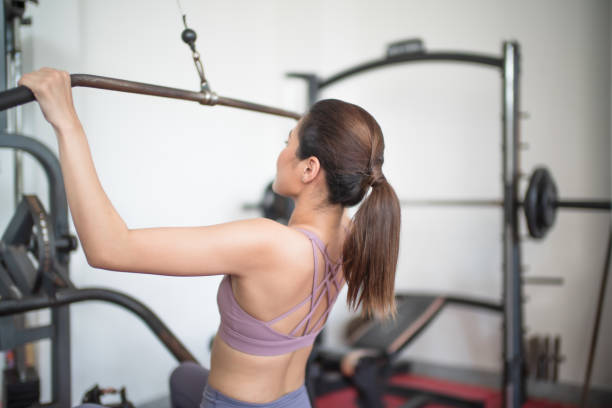
My Favorite: Best Back Exercises with Cables
Of all the exercises for the back, my personal favorites were the ones that involved cables. These best back exercises with cables, like the single-arm row and face pull, allowed me to target my upper back and refine the muscles in my back with precision.
The Transformative Power of Cable Workouts
Looking back, I can confidently say that integrating cable machine exercises into my routine was one of the best decisions I made for my fitness journey.
The benefits of doing back cable workouts were not just physical; they boosted my confidence and showed me the importance of versatility in training.
Whether you're a beginner or a seasoned athlete, the cable machine offers an array of exercises that can transform your back workouts and contribute to overall strength and wellness.
Remember, the key is to start where you are, use what you have, and do what you can. Happy lifting!
References
Fenwick, Chad M. J., Brown, Stephen H. M., & McGill, Stuart M. "Comparison of different rowing exercises: trunk muscle activation and lumbar spine motion, load, and stiffness." Journal of Strength and Conditioning Research 23.2 (2009): 350-358. DOI: 10.1519/JSC.0b013e3181942019.
For More Training Advice + Diet and Lifestyle visit us RIPL Fitness
PS: Make sure you check out the rest of our Back Training Guides:
10 Best Kettlebell Back Exercises & Back Workout
5 Best Calisthenics Back Exercises + Calisthenics Back Workout
5 Best Lower Back Exercises + Best Back Exercises Machines
Top 10 TRX Exercises To Build A Stronger Back
10 Best Resistance Band Back Exercises + Back Workout
11 Best Landmine Exercises For Back & Upper Body
15 Best Smith Machine Back Exercises
Top 3 Back Exercises For A Stronger Back: Build Size And Strength

